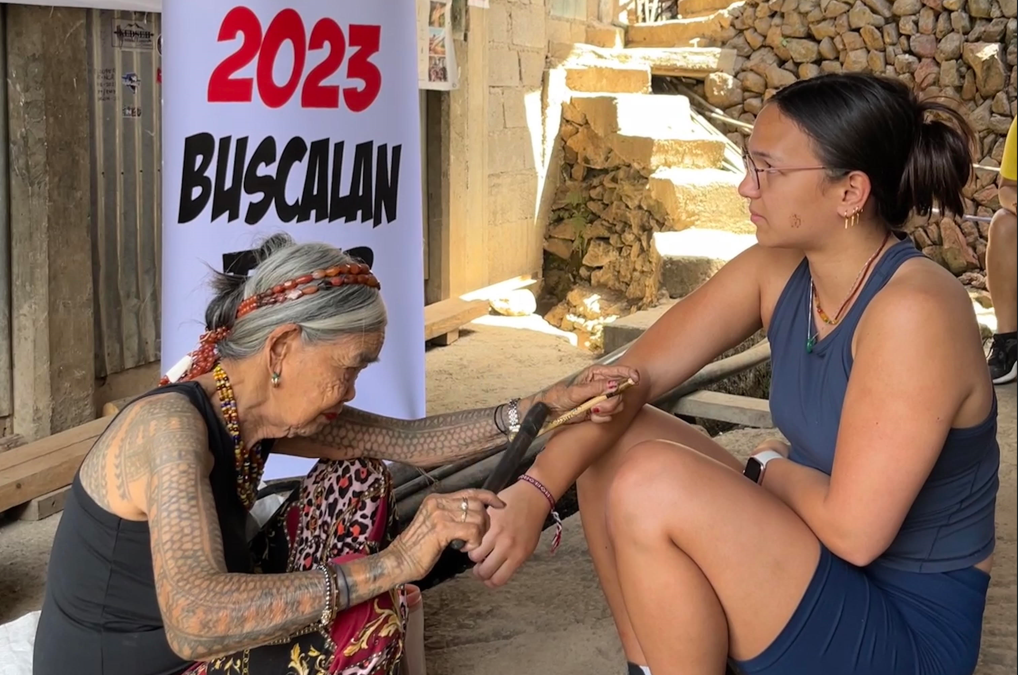Interactions with the last mambabatok
My authentic story of getting a traditional tattoo in the Buscalan Tattoo Village of the Philippines.
With just a 10-hour car ride and an hour-long hike up the mountains of Kalinga, the general public can easily meet Apo Whang-Od, a 106-year-old woman who performs batok, a traditional indigenous Filipino tattoo. Originating from the pre-Hispanic Philippine people of the 16th century, batok has now grown exceptionally popular thanks to Whang-Od. Her growing fame has encouraged people from across the globe to make social media posts and videos about their experiences.
This was my experience.
In May 2023, just after winter semester exams finished, my mother and I hopped on a plane back home to the Philippines. Having seen Whang-Od all over my social media, TV screens, and even on the cover of Vogue, I was determined to meet her. Near the end of our trip, it was finally time to get in a van with our private tour company. The first reality check that hit me in my “movie-like” experience was the hefty dent this booking made in my bank account.
Having left Manila the night before, we drove six hours and crept our way up to the mountains of Kalinga around three in the morning. Little did I know, one of the hardest parts of the trip was about to begin. We drove onto the ever-winding roads on the sides of the mountains—no guard rails or streetlights in sight. For the next four hours, my family and I endured the most nausea-inducing car ride I have ever experienced. Unfortunately for my mother, it got to her stomach. Still, we pressed on to the hour-long uphill hike through the rice fields. After what felt like a lifetime, we finally made it to the Buscalan Tattoo Village.
After a few hours of rest, it was finally time to meet the iconic Whang-Od herself. As she repeatedly hit the pomelo thorn into my skin, my family crowded around to take photos and videos. Blood started to drip down my wrist; it was the coolest thing ever. The rest of the group got their three dots and headed back to their rooms. After I finished, I took a quick nap and spent the rest of the day watching Whang-Od’s grand nieces, Grace and Elyang, tattoo the more impressive pieces. The girls getting tattooed before me were going for much larger and more intricate pieces than I would have been able to handle: a gorgeous traditional python wrapped around the forearm and an hourglass pattern completely down the shin. Since these evidently took a lot of time, I had to wait until morning to start my design.
Excited and energized after a full night’s rest, it was finally my turn. Elyang used a piece of straw from the roof to map out the snakeskin band around my bicep, representing strength and protection. Although the first poke was quite painful, each tap left my arm more numb, which made the process more tolerable. Besides, the pain wasn’t as bad as I had imagined it would be on my tricep and inner bicep. Two hours later, it was finally time to start the journey back to Manila.
This time, the winding roads got to my stomach. Dizziness aside, my arm was throbbing. My skin was hot, my bicep was swollen, and I was on the brink of tears. The only thing getting me through the next 10 hours was the slightly cooling sensation of the baby wipes used to wipe the ink. Finally, we were back in the city, and I could let the completely natural healing process take over. Over the next week my arm bruised and turned varying shades of purple and yellow. Pain aside, I continued to flaunt my new tattoo with pride. After months of healing, I now wear what is—and will always be—the most significant work of art I have ever put on my body.
Having the opportunity to truly get in touch with my culture through tattooing allowed me to learn about traditional practices and keep a reminder of the experience on my body for the rest of my life. The fact that I was able to do this with one of the most legendary tattoo artists in the world makes it even more special.
Although much of the journey was exhausting and made my mother question why we even decided to go forward with it, everything was worth it. Being able to experience first-hand a village I had only read about and the conversations I got to have with Grace about how far this practice has come in the tourist world truly trumps the time, energy, and money put into it.
The sentimental value and my understandings of what these tattoos symbolize have influenced my thinking about all of my current and future pieces, where each one should represent an important value I uphold in life. A daily reminder of these values pushes me to be my very best everyday through all of my actions—big or small.
Associate Opinion Editor (Volume 50) —Tia is a third-year student completing a double major in Anthropology and Sociology. She uses The Medium as an outlet to do some creative writing that can't be expressed through the countless academic papers she writes during the semester. When she's not writing for the opinion section, you can find Tia getting gains in the gym, working at the campus pool, or volunteering with UTM ECSpeRT!


